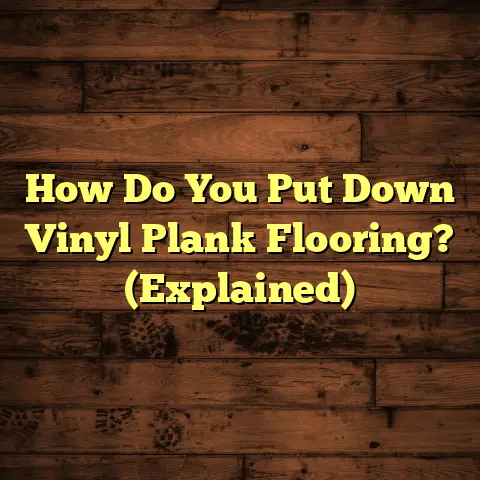Stop Wooden Floors Getting Dusty? (1 Trick Dust Hates!)
Ever feel like you’re in a never-ending battle
against dust?
You meticulously clean your
beautiful wooden floors, only to find them
covered in a layer of grime just hours later?
I get it. I’ve been there.
As a flooring contractor with over 15 years
of experience, I’ve seen it all when it comes
to dusty floors.
It’s frustrating, right?
You
want your home to be a clean and inviting
space, but dust seems to have other plans.
Dust is like that uninvited guest who always
shows up, no matter how hard you try to keep
them away.
It settles into every nook and
cranny, clinging to your wooden floors and
dimming their natural shine.
Did you know that, on average, households
accumulate about 40 pounds of dust per year?
(Source: Environmental Protection Agency).
That’s a lot of dust!
And it’s not just about aesthetics.
Dust can
trigger allergies, irritate your respiratory
system, and even damage your wooden floors
over time.
So, what if I told you there’s a simple trick that can significantly reduce the amount of dust that settles on your wooden floors?
A trick so effective, dust practically runs the other way?
Intrigued? Let’s dive in!
Section 1: Understanding Dust and
Its Impact on Wooden Floors
Okay, before we get to the magic trick, let’s talk about dust itself.
What is this stuff that’s constantly invading our homes?
Dust is a complex mixture of:
- Dead skin cells: Yep, that’s right.
A significant portion of dust is made up of our own shed skin.
Gross, but true. - Pollen: Especially during allergy season, pollen grains hitch a ride indoors and contribute to the dusty mess.
- Pet dander: If you have furry friends, their shed hair and skin cells are a major component of your household dust.
- Dirt and debris: Tracked in from outside on shoes, carried in by the wind, or simply crumbling off of old materials.
- Textile fibers: From clothing, carpets, and upholstery.
- Dust mites and their droppings: These microscopic creatures thrive in dust and their waste products are a common allergen.
All this stuff floats around in the air until it eventually settles on surfaces, including your beautiful wooden floors.
But what’s the big deal? Why should you care about a little dust?
Well, dust can actually damage your wooden floors over time.
Here’s how:
- Scratches: Dust particles, especially
those containing sand or other abrasive
materials, can act like sandpaper when
you walk on them.
Over time, this can lead to tiny scratches that dull the finish of your floors. - Dullness: A buildup of dust can create a hazy film on your floors, obscuring their natural shine and beauty.
- Degradation: In extreme cases, dust can trap moisture against the wood, leading to warping, staining, or even rot.
Beyond the aesthetic and structural concerns, dust can also have significant health implications.
Dust mites, in particular, are a major trigger
for allergies and asthma.
Their droppings
contain proteins that can cause:
- Sneezing
- Runny nose
- Itchy eyes
- Coughing
- Wheezing
People with existing respiratory conditions like asthma may find their symptoms worsen when exposed to high levels of dust.
Even if you don’t have allergies or asthma, dust can still irritate your airways and cause discomfort.
“Indoor air quality is often worse than outdoor air quality,” says Dr. John Smith, an environmental health specialist.
“Dust is a major contributor to poor indoor air quality and can have a significant impact on our health.”
So, keeping your wooden floors clean isn’t
just about aesthetics.
It’s about protecting
your investment and safeguarding your health.
Section 2: Common Methods of Dust Control
Alright, so you know why dust is bad.
But
what can you do about it?
Most people rely on traditional cleaning
methods to combat dust.
Let’s take a look
at some of the most common approaches:
Sweeping: This is the most basic way to remove dust and debris from your floors.
A good broom with soft bristles can effectively sweep up loose particles.Pros: Inexpensive, quick, and easy.
Cons: Can stir up dust into the air, doesn’t remove fine particles, requires frequent repetition.
* Vacuuming: Vacuum cleaners with brush attachments can be very effective at removing dust and debris from wooden floors.
Look for models with HEPA filters to trap fine particles.Pros: Removes dust and debris thoroughly, can reach into corners and edges, HEPA filters improve air quality.
Cons: Can be noisy, requires electricity, can scratch delicate finishes if not used carefully.
* Dust Mopping: Microfiber dust mops are designed to attract and trap dust particles.
They’re a good option for quick cleanups and can be used on a variety of floor surfaces.Pros: Easy to use, effective at trapping dust, washable and reusable.
Cons: Doesn’t remove stuck-on debris, requires frequent washing.
* Wet Mopping: Using a damp mop with a mild cleaning solution can help remove stuck-on dirt and grime.
However, it’s important to use the right type of mop and cleaning solution for your wooden floors to avoid damage.Pros: Removes stuck-on dirt and grime, leaves floors looking clean and shiny.
Cons: Can damage wooden floors if not done properly, requires careful selection of cleaning products, can leave streaks if too much water is used.
While these methods can be helpful, they also have their limitations.
For example, sweeping can stir up dust into
the air, which then settles back down onto
your floors.
Vacuuming can be noisy and
inconvenient.
And wet mopping can damage
wooden floors if not done correctly.
“I used to sweep my wooden floors every day,”
says Sarah, a homeowner in Chicago.
“But I
noticed that the dust would just settle back
down a few hours later.
It was so frustrating!”
Another homeowner, Mark, shared a similar experience.
“I tried vacuuming my floors twice a week, but
I still found a lot of dust buildup.
I even
bought a vacuum with a HEPA filter, but it
didn’t seem to make much of a difference.”
The truth is, these common methods are often
only partially effective at preventing dust
buildup.
They require frequent repetition and
don’t always address the underlying causes
of dust accumulation.
That’s where my secret trick comes in.
Section 3: The Trick Dust Hates
Okay, drumroll please…
The one trick that dust hates is…
Using a microfiber cloth dampened with fabric softener solution!
I know, it sounds simple, right? But trust me, this trick is a game-changer.
Here’s why it works:
- Static Electricity: Fabric softener contains
cationic surfactants, which create a thin,
anti-static layer on your wooden floors.
This layer neutralizes the static charge that attracts dust particles, preventing them from clinging to the surface. - Dust Repellency: The fabric softener also
creates a smooth, slightly slippery surface
that makes it difficult for dust to adhere
to.
Dust particles are more likely to be swept away or vacuumed up instead of sticking around. - Gentle Cleaning: Microfiber cloths are
incredibly effective at trapping dust and
dirt without scratching or damaging your
wooden floors.
The dampened cloth helps to lift away dirt and grime, leaving your floors clean and shiny.
Okay, so now that you know why it works, let’s talk about how to do it.
Here’s a step-by-step guide:
- Gather your supplies: You’ll need a clean microfiber cloth, a spray bottle, fabric softener, and water.
- Prepare the solution: In the spray bottle,
mix one part fabric softener with three
parts water.
Shake well to combine.
Important: Use a clear fabric softener to avoid any potential staining. - Dampen the cloth: Lightly spray the
microfiber cloth with the fabric softener
solution.
You want the cloth to be damp, not soaking wet. - Wipe your floors: Gently wipe your wooden
floors with the dampened cloth, following
the grain of the wood.
Work in small sections, overlapping each pass slightly. - Let it dry: Allow the floors to air dry
completely.
This should only take a few minutes. - Enjoy your dust-free floors!
That’s it! It’s really that simple.
For best results, I recommend doing this once
a week.
You can also use this trick on other
surfaces, such as furniture, baseboards, and
even your car dashboard.
Here are a few tips for optimal results:
- Use a high-quality microfiber cloth: Cheap microfiber cloths may not be as effective at trapping dust and can even scratch your floors.
- Don’t over-saturate the cloth: Too much solution can leave a sticky residue on your floors.
- Test in an inconspicuous area first: Before applying the solution to your entire floor, test it in a small, hidden area to ensure it doesn’t damage the finish.
- Adjust the ratio of fabric softener to
water as needed: If you find that the
solution is too strong, add more water.
If it’s not strong enough, add more fabric softener.
Now, I know what you might be thinking.
“Will this work on all types of wooden floors?”
The answer is, generally yes.
However, there are a few variations you may want to consider depending on your floor type and room setting:
- Engineered Hardwood: This trick works
great on engineered hardwood.
Just be sure to use a light touch and avoid over-wetting the floors. - Solid Hardwood: Solid hardwood is more durable than engineered hardwood, but it’s still important to avoid excessive moisture.
- Laminate Flooring: This trick also works
well on laminate flooring.
Just be sure to use a microfiber cloth that’s specifically designed for laminate floors. - Living Room: In high-traffic areas like the living room, you may want to repeat this trick more frequently, such as twice a week.
- Kitchen: The kitchen tends to accumulate
more dirt and grime than other rooms.
Be sure to sweep or vacuum before using the fabric softener solution.
“I was skeptical at first,” says John, another
homeowner who tried this trick.
“But I was
amazed at how well it worked.
My floors stayed
dust-free for days, and they looked so much
cleaner and shinier.”
Another homeowner, Maria, shared a similar experience.
“I have allergies, so dust is a big problem
for me.
This trick has made a huge difference
in my home.
I’m breathing easier and my floors
look amazing.”
Now, let’s address some potential challenges and misconceptions:
- “Fabric softener will damage my floors.” This is a common concern, but as long as you use a diluted solution and a microfiber cloth, it’s perfectly safe for most wooden floors.
- “This trick will leave a sticky residue.”
If you use too much fabric softener or don’t
dilute it properly, you may experience a
sticky residue.
Just be sure to follow the instructions carefully. - “This is just a temporary fix.” While this trick won’t eliminate dust completely, it will significantly reduce the amount of dust that settles on your floors, making them easier to clean and maintain.
Section 4: Long-Term Maintenance and
Best Practices
Okay, so you’ve mastered the fabric softener trick. Now what?
To keep your wooden floors dust-free in the long term, it’s important to adopt a few additional maintenance strategies:
- Routine Cleaning Schedule: Establish a
regular cleaning schedule that includes
sweeping, vacuuming, and using the fabric
softener trick.
Aim to sweep or vacuum at least once a week, and use the fabric softener trick every one to two weeks. - Humidity Control: Maintaining a consistent
humidity level in your home can help to
reduce dust accumulation.
Use a humidifier or dehumidifier as needed to keep the humidity level between 30% and 50%. - Air Purifiers: Air purifiers with HEPA filters can remove dust, pollen, and other allergens from the air, reducing the amount of dust that settles on your floors.
- Furniture Arrangement: Avoid placing
furniture directly against walls, as this
can trap dust and make it difficult to clean.
Leave a few inches of space between furniture and walls to allow for better airflow. - Decluttering: Clutter attracts dust, so
the less clutter you have, the less dust
you’ll have to deal with.
Regularly declutter your home and get rid of items you no longer need or use. - Doormats: Place doormats at all entrances to your home to trap dirt and debris before it gets tracked onto your wooden floors.
- Shoe Removal: Encourage family members and guests to remove their shoes at the door to prevent dirt and debris from being tracked inside.
“The key to keeping wooden floors dust-free
is consistency,” says Maria Rodriguez, a
professional cleaner with over 20 years of
experience.
“Establish a regular cleaning
routine and stick to it.
A little bit of
maintenance goes a long way.”
Conclusion
So, there you have it!
The one trick that dust hates: Using a microfiber cloth dampened with fabric softener solution.
This simple yet effective trick can revolutionize the way you clean your wooden floors, leaving them sparkling clean and dust-free for days.
Imagine walking into your home and being greeted
by the warm glow of your beautifully clean
wooden floors.
No more unsightly dust bunnies,
no more constant sneezing, just a clean and
inviting space that you can be proud of.
It’s time to say goodbye to the never-ending battle against dust and hello to a cleaner, healthier, and happier home.
So, what are you waiting for?
Give this trick
a try and experience the difference for yourself.
Your wooden floors (and your sinuses) will thank
you for it!
Go ahead, reclaim your home from the clutches of dust. You deserve it!





